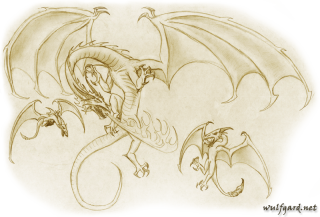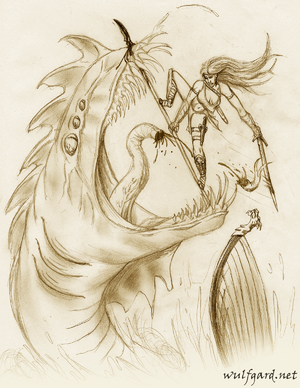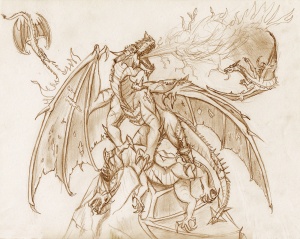Difference between revisions of "Dragon"
| Line 44: | Line 44: | ||
[[Gronvaenga|Gronvaenga, Guardian of Mimiriholt]] - Another truly ancient dragon of Midgard, the being known to Northmen as Gronvaenga is the green dragon who guards [[Mimiriholt]], the eternal forest. | [[Gronvaenga|Gronvaenga, Guardian of Mimiriholt]] - Another truly ancient dragon of Midgard, the being known to Northmen as Gronvaenga is the green dragon who guards [[Mimiriholt]], the eternal forest. | ||
| − | [[Rognosst (Dragon)|Rognosst]] - The primary deity of the reptilian [[Beastfolk|beastfolk]] that dwell within [[Rognosst Swamp]], particularly the lizardfolk, is a being they refer to as "the dragon god Rognosst," from which the swamp receives its name. | + | [[Rognosst (Dragon)|Rognosst]] - The primary deity of the reptilian [[Beastfolk|beastfolk]] that dwell within [[Rognosst Swamp]], particularly the [[Saurian|lizardfolk]], is a being they refer to as "the dragon god Rognosst," from which the swamp receives its name. |
| + | |||
| + | [[Silver (dragon)|Silver]] - Perhaps more frequently called "The Nameless One," the dragon also known simply as Silver is the creator and possible ruler of the supposed "city of dragons," [[Voc]]. He is considered to be bordering on godlike in terms of power, even for a dragon. | ||
[[Fafnir]] - A great red dragon who guarded an enormous hoard of dwarven gold. Legends say that he was once a [[Dwarves|dwarf]] himself who became a dragon through ancient [[Runic Magic|runic magic]] and a pure lust for gold, but the truth of this is disputed. He was slain by the hero Sigurd. | [[Fafnir]] - A great red dragon who guarded an enormous hoard of dwarven gold. Legends say that he was once a [[Dwarves|dwarf]] himself who became a dragon through ancient [[Runic Magic|runic magic]] and a pure lust for gold, but the truth of this is disputed. He was slain by the hero Sigurd. | ||
[[Category:Monsters]][[Category:Dragon-kin]] | [[Category:Monsters]][[Category:Dragon-kin]] | ||
Revision as of 15:57, 14 April 2017
Among the most mysterious and powerful creatures in all of Wulfgard, dragons (also called wyrms or drakes - the latter term often referring specifically to younger dragons) are enormous, highly intelligent, winged reptilian creatures of a magical nature. Cultures throughout the mortal realms have tales and legends involving dragons, though few individuals can claim to have seen one in person. True dragons are immortal and innately magical, able to breathe different types of arcane fire and speak.
Contents
Physical Appearance
Due to their magical nature, the physiology of dragons is random and unpredictable. Also, their appearance in stories and artistic depictions vary from place to place. In Northrim and northern reaches of the Achaean Empire, dragons appear more serpentine, with elongated tails, necks, and snouts. Deeper into Achaea, dragons seem to grow stockier and less elongated, with more spikes and horns. In the East, dragons appear long and snake-like, sometimes with lion-like faces and whiskers. Just how much of this regional variation is based on true dragon sightings and how much of it stems merely from local tradition is unclear. Dragons range in color from the deepest black to the brightest red, and their scales can be either dull as stone or shimmering like polished armor. Tales speak of dragons in an enormous variety of colors: some red, green, blue, purple, gold, silver, orange, black, white, or grey. Certain colors would seem to be associated with certain elements, and with the type of arcane fire the dragon might breathe. However, attempts by would-be dragon slayers to classify wyrms and predict what element they will use to attack have mostly ended in catastrophic failure.
Abilities
Dragons are innately magical creatures and seem to be connected to the elements. Some believe that one reason for their rarity is that they can fly between the realms, or at least between the mortal realm and their own elemental realm. Some scholars theorize that dragons can only breed in the mortal world, but return to their elemental realm upon reaching very old age, thus accounting for their rarity in Midgard. All true dragons have wings and can fly, though some can also swim or burrow underground. All dragons are covered in scales, which are extremely valuable due to their beauty, toughness, and resistance to the elements. Dragons are famous for their breath, most of them breathing some type(s) of arcane fire.
Behavior
Most tales, especially in the West, depict dragons as evil and greedy destroyers of humanity. Some associate a dragon's color with its disposition, painting black dragons as evil and gold as benevolent, but there is little evidence to back up these assumptions. As intelligent beings, all dragons have their own unique personalities, though certain stereotypes do apply. For the most part, it does seem to be true that dragons are vain and proud, considering themselves far superior to most other beings. And given their immense power and longevity, their viewpoint is not entirely unjustified. All mortals are advised to address dragons with great respect and reverence. Dragons are also very protective of what they consider theirs. This may be a hoard of gold, their eggs, or, in some cases, a beautiful forest they consider their home.
Dragon-slaying
Because of their rarity and near-impossibility to kill, there is no such thing as a 'dragon hunter' - merely monster hunters who someday dream of finding a dragon, much less slaying one. However, to slay a dragon would make one instantaneously wealthy. Their body parts, such as their scales and blood (which is as hot as magma when first spilled) have a wide number of alchemical and other uses. This is coupled with the fact that most dragons covet treasures like gold and gemstones, lining their lairs with a hoard of such jewelry and turning them into glittering golden palaces. Dragon scales are sometimes used to craft suits of armor, the value of which is almost beyond estimation. Most such suits, however - along with most of the dragon-based alchemical ingredients one might find - come not from the glorious slaying of a dragon, but from explorers merely finding one dead in a valley or on a mountainside. The slayer is rarely a man or elf, but more commonly another dragon or one of the giants.
Dragon-kin
Lesser dragons - sometimes called pseudodragons or dragon-kin - are creatures draconic in appearance but lacking most of the intelligence and power of their noble cousins, the true dragons. Such creatures include wyverns, basilisks, lindwurms, cockatrices, and sea serpents.
Hybrids
Some tales speak of dragons taking the form of men, either through magical illusion or through shapeshifting, and interacting with mortals. A few noble lineages of men claim to have dragon blood in their veins, and rarely explorers of the Jagged Edge claim to have encountered fearsome half-dragon, half-man guardians to deep caves and dragon lairs. Despite all this evidence, whether or not dragons can literally mate with men, elves, dwarves, or giants, and produce such offspring naturally - as opposed to unnaturally in the horrific breeding pits of the Jötnar - remains uncertain. If possible, such couplings would undoubtedly be rare, as most dragons consider interacting with lesser creatures highly distasteful - much less mating with them. A few legends even speak of "dracodemons" - children of dragons and demon lords.
Known Dragons
The following is a list of important dragons known to exist, or have once existed, either in the mortal realm or elsewhere.
Godlike Dragons
The Rainbow Serpent - Venerated under many different names by island peoples living on the fringes of the mortal realm, this great dragon is said to have feathers and prismatic scales that shift every color of the rainbow. Sometimes called the god of dragons, some believe that all dragons are his or her offspring. The Rainbow Serpent supposedly existed at the time of the world's creation, and it may be a son of Ormazd, god of light.
Typhon (Azi Dahaka) - Sometimes called the god of monsters, Typhon is said to have reigned over all the monsters and dragons on earth during the age of the Titans, before Zeus defeated him and cast him into the yawning void of Tartarus, from whence his firestorms still issue forth today. In the South, he is called Azi Dahaka. According to them, he is a son of Ahriman, the god of all darkness, evil, and chaos.
Echidna - The bride of Typhon, often depicted with the form of a winged half-woman, half-snake. She is said to dwell in a great crack in the Jagged Edge, so deep that it nearly reaches to the Underworld, so she can be as close as possible to her love imprisoned in Tartarus. Many monstrous races are the children of Typhon and Echinda, including Gorgons.
Nidhogg - The lord of all Black Dragons, Nidhogg dwells in the Underworld, where he survives by eating demons and gnawing on the roots of the world-tree Yggdrasil. One of the most ancient and powerful dragons in existence, even demon lords fear the shadow of his wings.
Fucanglong - Sometimes called the Lord of all Gold Dragons, he guards the immense treasure contained within the Underworld. His purpose is divine, since he keeps the demons from taking the Underworld's riches, which he sees as his hoard, making his the largest of any dragon hoard.
Tiamat - Queen Mother of the Sea Dragons, she dwells in the eternal waters of Oceanus, the Realm of Water. Of godly power, she never enters the mortal realm in person, but all sea dragons worship her as their mother goddess. Although legends speak of her being slain by the ancient god Marduk, he in fact only cut off one of her multiple heads, and she survived the attack.
Jormundgand - One of the children of Loki and Angerboda, the lord of all sea serpents. It is said that his body, lying beneath the ocean, wraps around the circumference of the world. He is prophesized to do battle with the gods during the Ragnarok.
Dragons of the Mortal Realm
Sturmkrag, Scourge of Midgard - A truly ancient dragon who is said to dwell near the heart of Vulcan's Forge, the huge active volcano in the Jagged Edge below Mount Olympos.
Gronvaenga, Guardian of Mimiriholt - Another truly ancient dragon of Midgard, the being known to Northmen as Gronvaenga is the green dragon who guards Mimiriholt, the eternal forest.
Rognosst - The primary deity of the reptilian beastfolk that dwell within Rognosst Swamp, particularly the lizardfolk, is a being they refer to as "the dragon god Rognosst," from which the swamp receives its name.
Silver - Perhaps more frequently called "The Nameless One," the dragon also known simply as Silver is the creator and possible ruler of the supposed "city of dragons," Voc. He is considered to be bordering on godlike in terms of power, even for a dragon.
Fafnir - A great red dragon who guarded an enormous hoard of dwarven gold. Legends say that he was once a dwarf himself who became a dragon through ancient runic magic and a pure lust for gold, but the truth of this is disputed. He was slain by the hero Sigurd.


